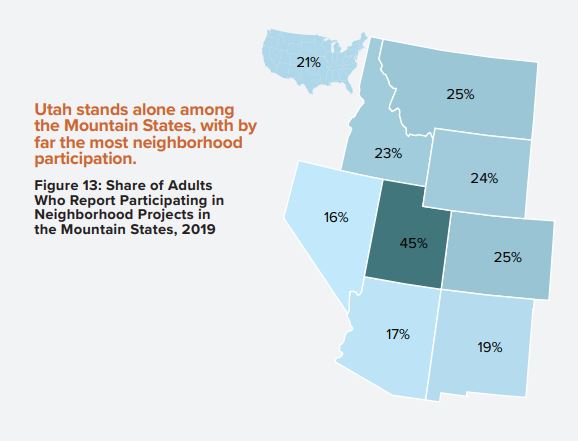UTAH SOCIAL CAPITAL SERIES
Check out the other sections of the Utah Social Capital Series. Links will become live as reports are published
- Civic Engagement
- Social Trust
- Community Life
- Family Health
- Social Cohesion
- Focus on Future Generations
- Social Mobility
- Overall Index
Alexis de Tocqueville observed Americans’ “art” of association when commenting on the types of associations he encountered – commercial, industrial, religious, general, specific, large and small. This installment in the Utah Social Capital Series seeks to measure participation in community life. The art of association opens the way not only for citizens to come together to address common challenges, but also to form social capital through their participation in community life. We examine this participation using six metrics: charitable donations; volunteering; at tendance at religious services; participation in neighborhood groups; the number of non-professional organizations; and the number of professional organizations.
KEY FINDINGS OF THIS REPORT
- Associational life has been a key characteristic of American culture, but it is in long-term decline.
- Utah is at or next to the top in the nation on four of the six measures of participation in community life. On the other two measures, however, Utah is below average – and in last place on one.
- Utah’s charitable giving has consistently outpaced the U.S. at large by a wide margin. In 2019, 66% of Utahns made donations, compared to only 50% of Americans overall. Utah ranked second overall, behind only South Dakota.
- Utah consistently outperforms the nation at large in volunteerism – and by a wide margin. No other state has as vigorous a culture of volunteerism.
- The most recent data put Utah clearly in first place nationally for weekly religious service attendance. However, there has been a notable decline in attendance.
- Utah has by far the nation’s highest level of neighborhood participation.
- Utah is dead last in the nation when it comes to the number of non-professional organizations per capita.
- Utah is below the national average for the number of professional organizations per capita
One of the most influential works ever produced on social capital documented a decline in associational life, with a title that says all. Robert Putnam’s 2000 landmark work “Bowling Alone” draws from the example of declining bowling leagues to emblemize the disintegration of community participation. This disintegration not only eats away at our social fabric, it can also diminish our mental and physical health. Recent developments, such as the increasing time spent on personal technology devices and the lockdowns in response to the coronavirus pandemic, may only be encouraging these trends. Still, some are hopeful that the movement over the past 60 years from a “we” society to an “I” society can be arrested.


